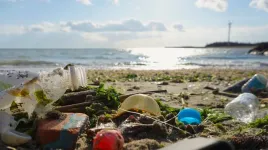(Press-News.org) Harnessing energy from plasma requires a precise understanding of its behavior during fusion to keep it hot, dense and stable. A new theoretical model about a plasma’s edge, which can become unstable and bulge, brings the prospect of commercial fusion power closer to reality.
“The model refines the thinking on stabilizing the edge of the plasma for different tokamak shapes,” said Jason Parisi, a staff research physicist at PPPL. Parisi is the lead author of three articles describing the model that were published in the journals Nuclear Fusion and Physics of Plasma. The primary paper focuses on a part of the plasma called the pedestal, which is located at the edge. The pedestal is prone to instabilities because the plasma’s temperature and pressure often drop sharply across this area.
The new model is noteworthy because it is the first to match pedestal behaviors that were seen in the U.S. Department of Energy’s (DOE) Princeton Plasma Physics Laboratory (PPPL) National Spherical Torus Experiment (NSTX). While conventional tokamaks are shaped like donuts, NSTX is one of several tokamaks that are shaped more like a cored apple. The difference in tokamak proportions impacts plasma and, as the model indicates, the pedestal.
Ballooning instabilities
Parisi, together with a team of scientists, explored the limits of pedestals and investigated how much pressure could be applied to plasma inside a fusion reactor before instabilities appeared. In particular, they studied disruptions in the pedestal called ballooning instabilities: bulges of plasma that jut out, like the end of a long balloon when squeezed.
“The model is an extension of a model that people have used in the field for maybe 10 years, but we made the ballooning stability calculation a lot more sophisticated,” Parisi said.
To develop their model, the scientists looked at the relationship between pedestal measurements — height and width — and ballooning instabilities. Parisi said the new model fit on the first try. “I was surprised by how well it works. We tried to break the model to ensure it was accurate, but it fits the data really well,” he said.
Expanding the EPED model
The existing model, known as EPED, was known to work for donut-shaped tokamaks but not for the spherical variety. “We decided to give it a go, and just by changing one part of EPED, now it works really well,” Parisi said. The results also give researchers a clearer picture of the contrast between the two tokamak designs.
“There is certainly a big difference between the stability boundary for the apple shape and the standard-shaped tokamak, and our model can now somewhat explain why that difference exists,” he said. The findings could help minimize plasma disruptions.
Tokamaks are designed to intensify the pressure and temperature of plasma, but instabilities can thwart those efforts. If plasma bulges out and touches the walls of the reactor, for example, it can erode the walls over time. Instabilities can also radiate energy away from the plasma. Knowing how steep a pedestal can be before instabilities occur could help researchers find ways to optimize plasmas for fusion reactions based on the proportions of the tokamak.
While he added that it’s not yet clear which shape is more advantageous, the model suggests other experiments that would try to exploit the positive aspects of the apple shape and see how much benefit they could provide.
Fundamentally, the new model enhances our understanding of pedestals and brings scientists closer to achieving the greater goal of designing a fusion reactor that generates more power than it consumes.
Plasma shape and pedestal measurements
Parisi’s second paper in the series explores how well the EPED model aligns with the height and width of the pedestal for different plasma shapes.
“Your core fusion pressure, and therefore your power, is so sensitive to how high your pedestal is. And so, if we were to explore different shapes for future fusion devices, we definitely want to make sure that our predictions work,” he said.
Parisi started with old data from experimental discharges in NSTX and then modified the plasma’s edge shape. He found that changing the shape had a very big effect on the width-to-height ratio of the pedestal. Additionally, Parisi found that some shapes could lead to several possible pedestals — particularly in tokamaks shaped like NSTX and its descendant, which is currently being upgraded, NSTX-U. This would give those running a fusion shot a choice between, for example, a steep or shallow pedestal.
“When people came up with these pedestal models, they were trying to predict the pedestal width and height because it can change the amount of fusion power generated by a lot, and we want to be accurate,” Parisi said. “But the way that models are constructed at the moment, they only take into account plasma stability.”
Heating, fueling and pedestals
Heating and fueling are other important factors and ones that Parisi’s third paper explores. Specifically, Parisi looked at certain pedestals and determined the amount of heating and fueling required to achieve it given a particular plasma shape. A steep pedestal typically requires far more heating than a shallow pedestal, for example.
The paper also considers how a sheared flow, which occurs when adjacent particles move at different flow speeds, can impact the pedestal height and width. Past experiments in NSTX found that when part of the interior of the vessel was coated in lithium and the flow shear was strong, the pedestal became three to four times wider than when no lithium was added. “It seems to be able to allow the pedestal to continue to grow,” said Parisi. “If you could have a plasma in a tokamak that was all pedestal, and if the gradients were really steep, you would get a really high core pressure and a really high fusion power.”
Understanding the variables involved in getting to a stable, high-power plasma brings researchers closer to their ultimate goal of commercializing fusion power.
“These three papers are really important for understanding the physics of spherical tokamaks and how the plasma pressure organizes into this structure where it increases sharply at the edge and maintains high pressure in the core. If we don’t understand that process, we can’t confidently project to future devices, and this work goes a long way toward achieving that confidence,” said deputy director of research for NSTX-U and co-author of the papers Jack Berkery.
Support for this research comes from the DOE under contract numbers DE-AC02-09CH11466, DE-SC0022270, DE-SC0022272 and the DOE Early Career Research Program. Co-authors of the paper include researchers from PPPL and six collaborative institutions across the U.S.
PPPL is mastering the art of using plasma — the fourth state of matter — to solve some of the world's toughest science and technology challenges. Nestled on Princeton University’s Forrestal Campus in Plainsboro, New Jersey, our research ignites innovation in a range of applications including fusion energy, nanoscale fabrication, quantum materials and devices, and sustainability science. The University manages the Laboratory for the U.S. Department of Energy’s Office of Science, which is the nation’s single largest supporter of basic research in the physical sciences. Feel the heat at https://energy.gov/science and https://www.pppl.gov.
END
Apple versus donut: How the shape of a tokamak impacts the limits of the edge of the plasma
PPPL scientists investigate the relationship between the height and width of a fusion plasma’s edge region and ballooning instabilities
2024-05-28
ELSE PRESS RELEASES FROM THIS DATE:
Valentin Fuster, MD, PhD, receives prestigious award from World Heart Federation
2024-05-28
The World Heart Federation (WHF) is honoring Valentin Fuster, MD, PhD, President of Mount Sinai Heart and Physician-in-Chief of The Mount Sinai Hospital, with its Lifetime Achievement Award for 2024. This top honor recognizes his remarkable contributions to the WHF mission, and to the entire cardiovascular disease community for his dedication to combating this disease worldwide.
The WHF will present Dr. Fuster with this award on Saturday, May 25, during the World Heart Summit in Geneva, Switzerland.
“I am proud of this award, particularly because it represents Mount Sinai’s worldwide scientific contributions and dedication to advancements in the cardiovascular ...
Nonlinear photochromic properties in a perylene-substituted rhodamine spirolactam
2024-05-28
Photochromic compounds, which change their color when exposed to light, have been widely used as photoswitches to control different properties of materials. Nonlinear photochromic compounds, characterized by a nonlinear response to the intensity of incident light, have attracted special attention among researchers as the nonlinearity leads to enhanced contrast and improved spatial resolution in photochromic reactions. It also allows for multiple photochromic properties in a single molecule with a single light source. These qualities have made them valuable in nonlinear optical and holographic elements, super-resolution microscopy, and biomedical applications.
The simplest ...
Binge-eating disorder not as transient as previously thought
2024-05-28
BELMONT, Mass. (May 28, 2024) Binge-eating disorder is the most prevalent eating disorder in the United States, but previous studies have presented conflicting views of the disorder’s duration and the likelihood of relapse. A new five-year study led by investigators from McLean Hospital, a member of the Mass General Brigham healthcare system, showed that 61 percent and 45 percent of individuals still experienced binge-eating disorder 2.5 and 5 years after their initial diagnoses, respectively. These results contradict previous ...
Pharmacists prove effective, less costly care option for minor illnesses
2024-05-28
SPOKANE, Wash. – Greater use of pharmacists to treat minor illnesses could potentially save millions of dollars in health care costs, according to new research led by Washington State University. The findings also indicate a way to improve healthcare access by expanding availability of pharmacists’ clinical services including prescribing medications, amid an ongoing shortage of primary care providers.
The study found that care for a range of minor health issues – including urinary tract infections, shingles, animal bites and headaches – costs an average of about $278 less when treated in pharmacies compared to patients with similar ...
Inexpensive microplastic monitoring through porous materials and machine learning
2024-05-28
Optical analysis and machine learning techniques can now readily detect microplastics in marine and freshwater environments using inexpensive porous metal substrates. Details of the method, developed by researchers at Nagoya University with collaborators at the National Institute for Materials Sciences in Japan and others, are published in the journal Nature Communications.
Detecting and identifying microplastics in water samples is essential for environmental monitoring but is challenging due in part to the structural similarity of microplastics with natural organic compounds derived from biofilms, algae, and decaying organic matter. Existing detection methods ...
Mystery of ‘slow’ solar wind unveiled by Solar Orbiter mission
2024-05-28
Scientists have come a step closer to identifying the mysterious origins of the ‘slow’ solar wind, using data collected during the Solar Orbiter spacecraft’s first close journey to the Sun.
Solar wind, which can travel at hundreds of kilometres per second, has fascinated scientists for years, and new research published in Nature Astronomy, is finally shedding light on how it forms.
Solar wind describes the continuous outflow of charged plasma particles from the Sun into space – with wind travelling at over 500km ...
Study suggests ‘biodegradable’ teabags don’t readily deteriorate in the environment and can adversely affect terrestrial species
2024-05-28
Some teabags manufactured using plastic alternatives do not degrade in soil and have the potential to harm terrestrial species, a new study has shown.
The research looked at commonly available teabags made using three different compositions of polylactic acid (PLA), which is derived from sources such as corn starch or sugar cane.
The teabags were buried in soil for seven months, and a range of techniques were then used to assess whether – and to what extent – they had deteriorated.
The results showed that teabags made solely from PLA remained completely intact. However, the ...
Algorithms could help improve judicial decisions
2024-05-28
A new paper in the Quarterly Journal of Economics, published by Oxford University Press, finds that replacing certain judicial decision-making functions with algorithms could improve outcomes for defendants by eliminating some of the systemic biases of judges.
Decision makers make consequential choices based on predictions of unknown outcomes. Judges, in particular, make decisions about whether to grant bail to defendants or how to sentence those convicted. Companies now use machine learning based models increasingly in high-stakes decisions. There are various assumptions about human behavior underlying the deployment of ...
Scientists uncover a multibillion-year epic written into the chemistry of life
2024-05-28
The origin of life on Earth has long been a mystery that has eluded scientists. A key question is how much of the history of life on Earth is lost to time. It is quite common for a single species to "phase out" using a biochemical reaction, and if this happens across enough species, such reactions could effectively be "forgotten" by life on Earth. But if the history of biochemistry is rife with forgotten reactions, would there be any way to tell? This question inspired researchers from the Earth-Life Science Institute (ELSI) at the Tokyo Institute of Technology, and the California Institute of Technology (CalTech) ...
Monitoring diseases through sweat becomes accessible to everyone
2024-05-28
Sweat contains biomarkers that can monitor various health conditions, from diabetes to genetic disorders. Sweat sampling, unlike blood collection, is preferred by users due to its painless nature. However, to obtain sufficient nutrients or hormones from sweat for testing, intense physical activity was previously required to induce sweat. This method posed challenges for individuals with limited mobility.
Dr. Kim Joohee from the Bionics Research Center at the Korea Institute of Science and Technology (KIST, Director Oh Sangrok) and Professor John A. Rogers from Northwestern University jointly announced the development ...
LAST 30 PRESS RELEASES:
Why nail-biting, procrastination and other self-sabotaging behaviors are rooted in survival instincts
Regional variations in mechanical properties of porcine leptomeninges
Artificial empathy in therapy and healthcare: advancements in interpersonal interaction technologies
Why some brains switch gears more efficiently than others
UVA’s Jundong Li wins ICDM’S 2025 Tao Li Award for data mining, machine learning
UVA’s low-power, high-performance computer power player Mircea Stan earns National Academy of Inventors fellowship
Not playing by the rules: USU researcher explores filamentous algae dynamics in rivers
Do our body clocks influence our risk of dementia?
Anthropologists offer new evidence of bipedalism in long-debated fossil discovery
Safer receipt paper from wood
Dosage-sensitive genes suggest no whole-genome duplications in ancestral angiosperm
First ancient human herpesvirus genomes document their deep history with humans
Why Some Bacteria Survive Antibiotics and How to Stop Them - New study reveals that bacteria can survive antibiotic treatment through two fundamentally different “shutdown modes”
UCLA study links scar healing to dangerous placenta condition
CHANGE-seq-BE finds off-target changes in the genome from base editors
The Journal of Nuclear Medicine Ahead-of-Print Tip Sheet: January 2, 2026
Delayed or absent first dose of measles, mumps, and rubella vaccination
Trends in US preterm birth rates by household income and race and ethnicity
Study identifies potential biomarker linked to progression and brain inflammation in multiple sclerosis
Many mothers in Norway do not show up for postnatal check-ups
Researchers want to find out why quick clay is so unstable
Superradiant spins show teamwork at the quantum scale
Cleveland Clinic Research links tumor bacteria to immunotherapy resistance in head and neck cancer
First Editorial of 2026: Resisting AI slop
Joint ground- and space-based observations reveal Saturn-mass rogue planet
Inheritable genetic variant offers protection against blood cancer risk and progression
Pigs settled Pacific islands alongside early human voyagers
A Coral reef’s daily pulse reshapes microbes in surrounding waters
EAST Tokamak experiments exceed plasma density limit, offering new approach to fusion ignition
Groundbreaking discovery reveals Africa’s oldest cremation pyre and complex ritual practices
[Press-News.org] Apple versus donut: How the shape of a tokamak impacts the limits of the edge of the plasmaPPPL scientists investigate the relationship between the height and width of a fusion plasma’s edge region and ballooning instabilities






